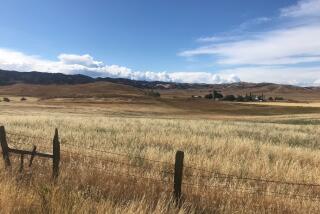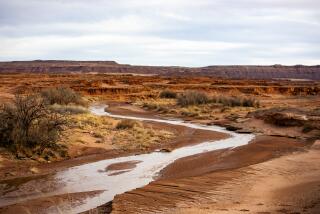Plan to Store Water Below Desert Gains
The Department of Interior on Thursday gave its approval to a controversial $1-billion, 50-year project to store and pump water from beneath the Mojave Desert and create one of California’s largest water storage facilities.
“We’re thrilled,” said Wendy Mitchell, spokeswoman for Santa Monica-based Cadiz Inc., which owns the land above the aquifer in eastern San Bernardino County.
Under the proposal, which still faces political and economic questions, the Metropolitan Water District of Southern California would store surplus water from the Colorado River in the aquifer and during dry years pump aquifer water into the MWD system, which supplies water to 17 million people in six counties.
If the MWD approves the project, the agency and thus the public would bear a substantial part of the estimated $150-million cost.
Cadiz would be paid by the MWD for each acre-foot of water pumped from the aquifer, which some critics see as an ominous reversion to the days when water systems were privately owned by for-profit companies. Two other desert storage projects being devised by the MWD include only public agencies.
Even though the MWD has spent several years and $3 million devising the proposal, agency officials were cautious Thursday when asked whether it will be adopted by the board of directors. A meeting is set for Sept. 17.
Jeff Kightlinger, MWD’s general counsel, said that the state’s “access to [surplus] Colorado River water is in some jeopardy at this moment” because of drought and the inability of California water agencies to strike a deal to meet a Dec. 31 deadline to avoid a mandatory water cutback from the federal government.
The Cadiz deal, Kightlinger said, will have to be evaluated in light of that uncertainty. Adan Ortega, MWD vice president for external affairs, said he did not want to prejudge what the staff will recommend to the board.
“Ultimately, it will be a business decision,” he said.
The proposed project has been criticized by environmentalists and Sen. Dianne Feinstein (D-Calif.) as a danger to the aquifer and the fragile desert ecology it supports. An arcane disagreement exists among scientists about how quickly the aquifer will be recharged by mountain rainfall.
But scientists at the Department of Interior concluded that a warning system devised by the partners and government agencies would give sufficient notice if the aquifer were being drawn down too quickly.
“We believe that the management plan, which is based on science and a strong monitoring program, will assure the necessary protection of the natural resources for which we are responsible,” said Rebecca Watson, assistant secretary of interior for land and minerals management.
Feinstein has sponsored a rider to an appropriation bill aimed at killing the project. But the prospects of that bill are uncertain.
The Department of Interior decision was immediately denounced by some environmentalists.
Elden Hughes, chairman of the Sierra Club’s California Desert Committee, said the project will leave “a scar on the land that will take centuries to heal.”
“We have an environmental disaster and economic fiasco,” Hughes said. He and others worry that bighorn sheep will be left without water, monumental dust storms will be created when the water table drops beneath dry lands, and ravens drawn by the spreading ponds will eat slow-moving tortoises.
Before the department decided to endorse the project, the concerns cited by Hughes and others were studied by the department and its subagencies and were rejected as exaggerated or unfounded.
For example, the U.S. Fish and Wildlife Service concluded in April that the project “is not likely to jeopardize the continued existence” of the desert tortoise, a federally protected species.
Environmentalists had asked that, at the very least, the federal government put limits on the amount of water that could be pumped annually. The Department of Interior, however, placed no such limits.
Part of the controversy about the Cadiz project involves Cadiz Chief Executive Keith Brackpool, a confidante and contributor to Gov. Gray Davis. As the Department of Interior staff was evaluating the project, Cadiz hired lawyers from a firm that once employed Interior Secretary Gale Norton to lobby on behalf of the project.
In a written statement, Brackpool said the proposal has “an environmental protection plan unrivaled within California’s water industry.”
Critics of Cadiz Inc. and the project have questioned its ability to shoulder the financial obligations of its partnership in the project.
Although Cadiz records most of its revenue from money-losing agricultural operations throughout the Central Valley, the company has made it clear that its future depends on the approval of the water project and others like it.
Under the tentative terms reached with the MWD, the construction cost of the project would be shared equally, but two-thirds of Cadiz’s $75-million share would actually come from an up-front payment to be made by the MWD. Cadiz Inc., which has never turned a profit, carries more than $140 million in annual debt, according to its latest financial statements.
Meanwhile, the company’s net worth or shareholders equity--the value of its assets after debt and other liabilities are subtracted--has declined to less than $9 million in June from nearly $50 million in 1998. At the most recent rate of shrinkage that figure would turn negative as soon as early next year.
The Department of Interior decision would allow the project partners to build a 34.6-mile pipeline and power distribution facilities from MWD’s Colorado Aqueduct to the aquifer.
More to Read
Sign up for Essential California
The most important California stories and recommendations in your inbox every morning.
You may occasionally receive promotional content from the Los Angeles Times.











